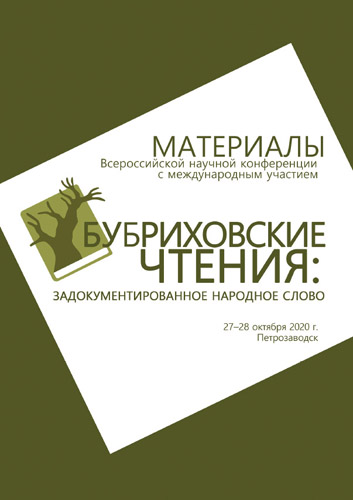
Материалы Всероссийской научной конференции с международным участием
«Бубриховские чтения: задокументированное народное слово» (Петрозаводск,
27–28 октября 2020 г.) [Электронный ресурс]
Отв. редактор: И.П. Новак.
2020. 190 с.
Indexed at RSCI
| Предисловие | 5 |
| Традиции Бубриховской школы всовременном финно-угроведении | 7 |
| N.N. Kolpakova. D. V. Bubrikh: we remember and honor (to the 130th anniversary of the birth) | 8 |
| O.E. Polyakov. D. V. Bubrikh – researcher of the Mordovian (Moksha and Erzya) languages | 11 |
| A.V. Andronov, M.B. Popov. Dmitry Bubrikh’s manuscript "On the origin of North Russian cokan’eand some other phenomena of the same sort" (1942) in a historical linguistic context | 14 |
| V.S. Tomelleri, G.V. Gordienko. D. V. Bubrikh and the germanic substrate hypothesis: the article "On the linguistic traces of the finnish teuton-chud’" (1926) and its unpublished versions | 21 |
| I.P. Novak. To the 130th anniversary of D. V. Bubrikh: clusterization in confirmation of the unity of the karelian language | 30 |
| S.A. Myznikov. New finno-ugorsk ethymologies according to the data of russian speaks of Belomorye | 34 |
| T.B. Agranat. Seto in Siberia | 38 |
| N.A. Agafonova, I.N. Ryabov. Archaic phenomena in case paradigms in the Erzya dialects of Novomalyklinsk District in Ulyanovsk Region | 42 |
| M.V. Kosheleva. Tehta or tehmaha: distribution of syntactic functions of the I and III infinitives in the Vepsian language | 46 |
| S.A. Minvaleev. Regarding the ethnic identification of the ludians issue | 51 |
| A.Iu. Zhukov. Marriage ties of the Karelian Volost of Tulmozero and ethnic consolidation of Livvi karelians of the Tulmozero (late 17th – mid-18th centuries) | 55 |
| Языковой образ мира: слово как отражение народной культуры | 71 |
| S.B. Egorov. Reflection of the historical memory of the vepsians in the legends | 72 |
| O.Iu. Zhukova. Lexical and structural-stylistic features of vepsian snakebite verbal charms texts | 76 |
| N.A. Pellinen. Designation of an infant in Karelian language: an ethnolinguistic aspect | 79 |
| G.V. Ryvkina. Traditional means of transportation of karelians through the prism of the Karelian-Finnish epic | 83 |
| E.V. Karakin. Abusive and obscene vocabulary in dialect dictionaries of the Karelian language | 86 |
| A.N. Rakin. Еlevated landscape nomination in the Komi-Permian language | 89 |
| I.V. Soloviev. Semantic problems of musical and ethnographic terminology in Saami musical tradition (interdisciplinary aspect of learning) | 93 |
| A.A. Afanaseva. Oikonyms with the selgy-element of Lake Syamozero territory: chronology and areal | 97 |
| E.V. Zakharova. Formation of the official sistem of oikonyms of Lake Vedlozero territory according to written sources | 101 |
| D.V. Kuzmin. The initial stage of the formation of the oikonymy of South Karelia | 105 |
| Художественное слово вареале языкового иэтнического пограничья | 109 |
| L.G. Gromova. On the occasion of the 200th anniversary of tver translated monuments of karelian script of the beginning of the 19th century | 110 |
| E.V. Evseeva. O. Kuusinen’s composition of "The Kalevala": origins, translation, editions (on the documents of the national archive of the Republic of Karelia) | 115 |
| E.G. Soini. The image of finland in the criticism of S. P. Diaghilev in the context of Russian-Finnish cultural relations of the 20th century | 118 |
| Ia.V. Novikova. Children’s speech in Kauko Röyhkä’s war novel "Maan korvessa kulkevi" | 123 |
| G.Iu. Sumarokov. The genre of urban fantasy in the context of contemporaryliterature of finland and russia in Johanna Sinisalo’s novel "The troll" and Max Fry’s novels of "Labyrinths of Echo" | 127 |
| I.S. Matashina. Russian motives in Kjell Westös roman "Mirage 38" | 131 |
| От картотеки до языкового корпуса | 135 |
| V.N. Maximov. Volzhsky dialect on the pages of Ödöna Beke’s dictionary (borrowed vocabulary) | 136 |
| T.P. Boyko. About some trends of modern word formation (based on dictionaries of the newly written karelian language) | 139 |
| T.P. Boyko. Materials of dialect dictionaries as a platform for creating normalized vocabulary in dictionaries new written karelian language | 143 |
| N.M. Mosina. Semantics of visual perception verbs in Erzya-Mordvin language (based on the moksher language corpus) | 147 |
| A.V. Chemyshev. The creation of the corpus of the marisamples of the speech | 151 |
| L.A. Abukaeva. Experience in creating dictionaries based on the national corpus of the Mari language (dictionary of comparisons and dictionary of epithets) | 154 |
| N.B. Krizhanovskaia, A.A. Krizhanovskii. From the VepKar corpus to the linguistic platform | 157 |
| Языковая политика, языковое планирование и преподавание финно-угорских языков в условиях межкультурной коммуникации | 160 |
| A.N. Runtova. "The construction of the terminology" of Tver karelians in the 30s of the 20th century | 161 |
| Z.I. Strogal’shchikova. "The speech written down shall not be obliviated" (from the history of vepsian and izhorian writing systems) | 165 |
| Iu.V. Litvin, M.V. Kundozerova, S.V. Lipnitskaia, E.N. Izergina, Ia.S. Shevchenko (Knureva). Karelian and belarusian languages in cyberspace: social, age and ethnic characteristics of language activists (experience of comparative analysis) | 171 |
| N.N. Shchemerova. Features of learning the lexical and semantic side of the second (Erzya) language by a preschool child | 174 |
| E.N. Kirkina. Mordovian children’s folklore as a means of familiarizing preschoolers with folk culture | 177 |
| A.A. Saikonen. Functional approach to the teaching of the Finnish language | 180 |
| M.V. Pekshieva. Audiotext in Finnish language teaching | 183 |
| Anna Maija Karhu. The effectiveness of teaching translation: adoption of text conventions during a translation course | 186 |
Last modified: December 8, 2020

![]() bubrihovskie_chtenija_2020.pdf (4.81 Mb, total downloads: 1076)
bubrihovskie_chtenija_2020.pdf (4.81 Mb, total downloads: 1076)


